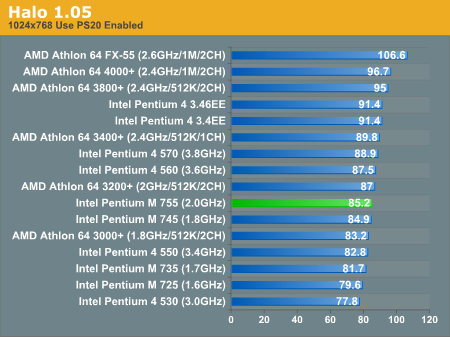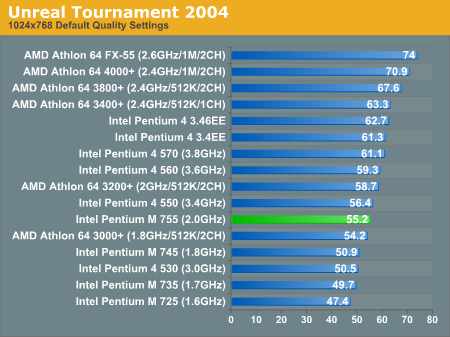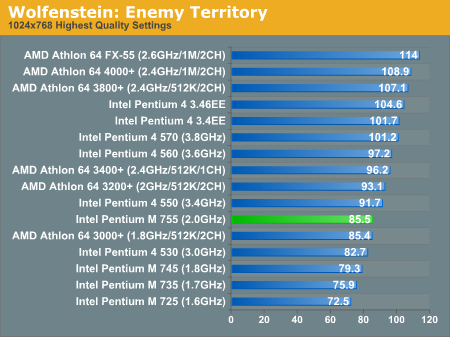Intel's Pentium M on the Desktop - A Viable Alternative?
by Anand Lal Shimpi on February 7, 2005 4:00 PM EST- Posted in
- CPUs
Gaming Performance
The Pentium M offers reasonably strong gaming performance, more competitive than the Pentium 4, but at such a low clock speed, and more importantly, without the memory bandwidth to back it up - the Pentium M isn't as solid of a performer as it could be here.Doom 3

Halo

Unreal Tournament 2004

Wolfenstein: ET











77 Comments
View All Comments
Jeff7181 - Monday, February 7, 2005 - link
Give the Dothan a speed bump and some dual channel DDR400 and stay out of it's way...MDme - Monday, February 7, 2005 - link
well, now we FINALLY have a comprehensive review of the P-M, it's strengths and weaknesses. While the P-M is good. the A64 is still better.Netopia - Monday, February 7, 2005 - link
Yeah, I was about to say the same as #3.Why did you go to the trouble to list what the AthlonXP system would have in it and then not actually test or reference it anywhere in the article?
I still have a bunch of AXP machines and regularly help others upgrade using XP-M's, so it would be interesting to see these at least included in reviews for a while.
CrystalBay - Monday, February 7, 2005 - link
Hi, I noticed in the testbed an AXP3200/NF2U400 but there are no charts with this setup.Beenthere - Monday, February 7, 2005 - link
It's a pipe dream for those who wish Intel had their act together. It's already confirmed M don't scale well and is not effective for HD computing. It's performance is really some place between Sempron and A64 but certainly not a suitable competitor to A64 nor FX. Just another Hail Mary for a defunct Intel.coldpower27 - Monday, February 7, 2005 - link
Hmm, an interesting review on the Pentium M to say the least. Though are 2-2-2-10 timings for the Pentium M the best for this architecture???0ldman79 - Wednesday, January 26, 2022 - link
It's interesting coming back and reading this after it's all settled, Core 2 seemed to be an evolution of the Pentium M line.Intel did hang the Netburst architecture up, though they added a lot of Netburst's integer design to Core 2 while designing Nehalem. AMD apparently believed that Intel was going to stick with Netburst and designed the FX line, while Intel went back to their earlier designs and lowered the clock speed, massively increased the IPC and parallelism and out-Phenom'ed the Phenom with Nehalem.
Back then Intel believed that Dennard scaling would continue and they'd have 10GHz chips, turns out wider and slower is better.